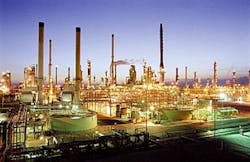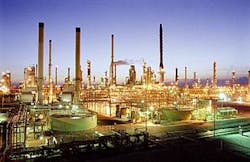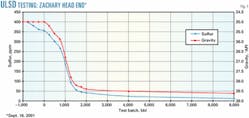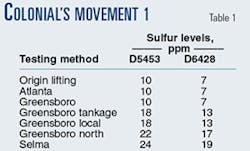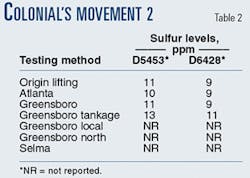Oil pipelines may have difficulty adjusting operations to the 15-ppm sulfur rule for ultra-low sulfur diesel (ULSD), based on tests conducted on two US product pipelines and reported on at a workshop on the subject in Houston last month.
The US Environmental Protection Agency conducted the 2-day workshop, which was jointly sponsored by several industry associations.
Wesley Neff, retired from but on consultancy for Marathon Ashland Pipe Line LLC, related details and results of one of four tests conducted on the MAPL system in 2001.
Buster Brown of Colonial Pipeline Co. reported on pipeline tests conducted on that system in 2001 and 2002. By volumes moved (bbl-miles), Colonial is annually the US leader.
Uncharted territory
MAPL conducted its tests on four segments ranging in size from 10 in. to 20 in. and in length from 70 miles to 250 miles.
Neff reported on the most recent test, on the 70 mile, 20-in. segment between MAPL's Garyville, La., refinery and its Zachary, La., tank farm.
"This test is representative of all the tests [MAPL] performed," said Neff, noting that a second test was conducted in April 2002.
MAPL's distribution system has no experience handling an ultra-low-sulfur specification product in a batching system. At 15-ppm sulfur, he said, ULSD would be the lowest-sulfur product in the system.
Assuming that the specification in pipelines will need to be about 10 ppm and comparing it to a heating-oil specification of 5,000 ppm, he said the product specification ratio would be 500:1. "The system has only dealt with sulfur specifications in the 10:1 range," he said.
The example he gave was that a 0.1% contamination—10 bbl in 10,000 bbl—of 5,000-ppm sulfur heating oil into ULSD would raise the sulfur content in the ULSD by 5 ppm.
Neff said MAPL took several precautions for its ULSD tests, among them:
- Automatic sumps were locked out. "We had one gasoline test spoiled because of a sump injection of high sulfur material into the test batch," said Neff.
- Booster pump units along the pipeline were not started unless they had been purged with ULSD.
- The tests were conducted with simple refinery-tank-to-terminal-tank movements, with no stops along the way.
- No pipeline shutdowns were scheduled while ULSD was in the system, and the lines used for the tests have only minor elevation changes.
- Tank lines and tanks were emptied before arrival of ULSD.
- Special sampling procedures ensured all sample lines were thoroughly flushed, samples taken with precise timing and with detailed labeling.
MAPL's tests aimed at determining whether sulfur from other refined products will "trail-back" in the pipeline, which batch sequences work well and what amount of interface will be generated, the extent of sulfur degradation due to the originating tank and receipt manifold piping, the pipeline and its associated facilities, or the delivery manifold, tank piping, and transport-loading equipment, and the appropriate field test for sulfur.
In the September 2001 test, the Garyville refinery made 90,000 bbl of ULSD, 7 ppm sulfur and 38.7° API. By the time the batch had moved to the refinery's storage tank, sulfur had increased to 10 ppm, indicating "how easily ULSD can be contaminated," said Neff.
For the test, MAPL lifted about 76,500 bbl into the Garyville-to-Zachary line with low-sulfur diesel (about 400 ppm) at the head end and regular motor gasoline (about 180 ppm) at the tail.
Of the 76,588 bbl of 10-ppm ULSD lifted, the system delivered 73,034 bbl of 11-12 ppm ULSD to a clean and empty tank at Zachary. Volumes lost to interface made up 4.6% of the lifted amount, with the refinery tank at Garyville contaminating 4,000 bbl, as indicated earlier.
Among other results, said Neff, the MAPL tests revealed how easily ULSD moving through a distribution system can be contaminated, not only from residual but small amounts of higher sulfur product isolated in a refinery's piping system but also from the higher sulfur head end of the batch.
Once contamination occurs from the head end, however, MAPL's tests showed no migration of sulfur at the head or the tail ends of the batch interfaces beyond the normal gravity-interface zone, no sulfur degradation due to the pipeline and its associated facilities, and no sulfur degradation at the delivery piping of the receiving terminal.
The test batch then moved into Colonial's system.
In the end, Neff said, the MAPL tests suggest that pipelines should be able to transport ULSD and "maintain the sulfur specifications."
"We saw that gravity changes corresponded closely to the sulfur changes and that protective gravity cuts might be acceptable," he said (Fig. 1). The loss to interface in MAPL's tests should be about the same as its current critical cuts for gasoline and distillates.
"Keep in mind, however, that our tests were done from refinery tank to a terminal tank with no stops in between," he said. "We did our tests under ideal conditions."
Neff emphasized the need for in-line testing equipment to find any contamination that happens during transit and to help define cut points; "there just isn't any test equipment … available to do this," he said.
"The industry needs something that will find contamination [in] the ULSD batch while in transit and allow the operator to take action before off-specification material enters terminal tanks," he said.
Defining cut points would be another function of this in-line equipment. With interfacial sulfur content changing more rapidly than gravity, said Neff, it would be useful to be able to see sulfur as well as gravity during an ULSD cut.
He also said there may be an inadequate gravity difference between ULSD and wrap material to facilitate a cut. "Without in-line equipment, protective cuts will be necessary, increasing the amounts of interface created," said Neff.
The pipeline ULSD specification, he concluded, might need to vary batch by batch, depending on the origin and the destination. Complex pipeline systems involving several breakout tanks and multiple pipeline segments "could result in several ppm sulfur degradation."
'It's the preseason'
Colonial Pipeline's experiences were less sanguine. "Our results were bad," said Brown, beginning his presentation.
Colonial moved two sample batches of ULSD on its 36-in. line from Baton Rouge to Greensboro, NC, with sampling at Atlanta Junction in Georgia.
Movement 1, in 2001, did not show sulfur levels evening out until long after gravity change. "Our initial results indicated sulfur and gravity results were not tracking as well as" those from the MAPL tests, Brown said. "We saw sulfur changes before we saw changes in gravity," and Brown admitted Colonial could not explain why.
The other observation from Movement 1 was that sulfur levels between Louisiana and North Carolina rose significantly and inexplicably (Table 1).
In short, said Brown, "We were not successful at delivering that product into our intermediate tank at an acceptable [sulfur] level."
But, he said, the Movement 1 tests on the Colonial system were like the preseason in US professional football: "How we do in preseason is not necessarily how we're going to perform in the regular season—at least, that's what we hope," he said.
A test earlier this year, however, which he called "Movement 2," suggested that sulfur levels and gravity are more closely related.
When "we reached 100% gravity we also were very close to the correct sulfur levels, whereas with the [Movement 1] test, sulfur levels were changing well before gravity changes," said Brown.
He also said the batch in Movement 2 did not show the sharp rise in sulfur levels between lifting into the system in Louisiana and delivery at Greensboro, but sulfur levels still rose (Table 2).
On both movements of ULSD test batches, Colonial saw the volume of interface, the total interface from first change to 100%, to be "quite large, twice what we would expect from a typical movement.
"We're very concerned about the amount of interface [and are] trying to understand that," he said.
One possible explanation lies in the differing makeups of the two product batches: Movement 1 was wrapped completely in high-sulfur product: aviation kerosine on one side and high-sulfur fuel on the other; Movement 2, on the other hand, was completely wrapped in 500-ppm product, Colonial's current low-sulfur diesel.
"Even though they were wrapped in different products," said Brown, "we still saw roughly the same interface size."
Brown said Colonial's tests reveal that the "real issues" center on movements into and out of tankage where exist the "greatest risk and greatest possibility of contamination.
"Overdisplacement into tankage is the only way we now see to protect the product." But, he said, displacement is "more art than science" with several operational parameters dictating the size of displacement.
Both Colonial's tests led to the same conclusion: The sulfur level at lifting must be lower because handling of the product along the system will, for whatever reason, elevate sulfur levels at delivery.
